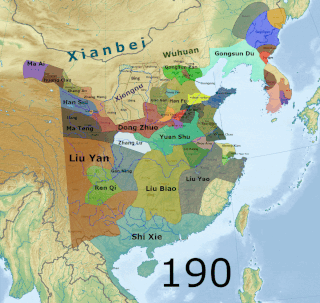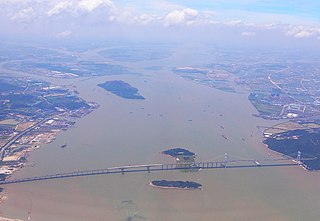The Wei River is a river in Hebei Province in northeastern China. It flows into Bohai Bay.
The Wei River is a river in Hebei Province in northeastern China. It flows into Bohai Bay.

The Three Kingdoms from 220 to 280 AD was the tripartite division of China among the dynastic states of Cao Wei, Shu Han, and Eastern Wu. The Three Kingdoms period was preceded by the Eastern Han dynasty and was followed by the Western Jin dynasty. The short-lived state of Yan on the Liaodong Peninsula, which lasted from 237 to 238, is sometimes considered as a "4th kingdom".

The Jin dynasty or the Jin Empire, sometimes distinguished as the Sima Jin (司馬晉) or the Two Jins (兩晉), was an imperial dynasty of China that existed from 266 to 420. It was founded by Sima Yan, eldest son of Sima Zhao, who had previously been declared the King of Jin. The Jin dynasty was preceded by the Three Kingdoms period, and was succeeded by the Sixteen Kingdoms in northern China and the Liu Song dynasty in southern China.

The Northern and Southern dynasties was a period of political division in the history of China that lasted from 420 to 589, following the tumultuous era of the Sixteen Kingdoms and the Eastern Jin dynasty. It is sometimes considered as the latter part of a longer period known as the Six Dynasties (220–589). Albeit an age of civil war and political chaos, it was also a time of flourishing arts and culture, advancement in technology, and the spread of Mahayana Buddhism and Daoism. The period saw large-scale migration of the Han people to the lands south of the Yangtze. The period came to an end with the unification of all of China proper by Emperor Wen of the Sui dynasty.

Wei, known in historiography as the Northern Wei, Tuoba Wei, Yuan Wei and Later Wei, was an imperial dynasty of China ruled by the Tuoba (Tabgach) clan of the Xianbei. The first of the Northern dynasties, it ruled northern China from 386 to 535 during the period of the Northern and Southern dynasties. Described as "part of an era of political turbulence and intense social and cultural change", the Northern Wei dynasty is particularly noted for unifying northern China in 439, bringing an end to the chaotic Sixteen Kingdoms period, and strengthening imperial control over the rural landscape via reforms in 485. This was also a period of introduced foreign ideas, such as Buddhism, which became firmly established. The Northern Wei was referred to as "Plaited Barbarians" by writers of the Southern dynasties, who considered themselves the true upholders of Chinese culture.

The Warring States period was an era in ancient Chinese history characterized by warfare, as well as bureaucratic and military reforms and consolidation. It followed the Spring and Autumn period and concluded with the Qin wars of conquest that saw the annexation of all other contender states, which ultimately led to the Qin state's victory in 221 BC as the first unified Chinese empire, under the Qin dynasty.

Wei was one of the seven major states during the Warring States period of ancient China. It was created from the three-way Partition of Jin, together with Han and Zhao. Its territory lay between the states of Qin and Qi and included parts of modern-day Henan, Hebei, Shanxi, and Shandong. After its capital was moved from Anyi to Daliang during the reign of King Hui, Wei was also called Liang.

The Wei River is a major river in west-central China's Gansu and Shaanxi provinces. It is the largest tributary of the Yellow River and very important in the early development of Chinese civilization. In ancient times, such as in the Records of the Grand Historian, the river was called Wei Shui.

The archaeological Gallery Roads were routes traversing remote mountainous regions of China. The roads were fashioned using wooden planks securely fastened within holes carved into cliff sides. Primarily found in the Qin Mountains, they connected the Wei River and the Han River valleys. The first gallery roads were built during the Warring States period and used by Qin to invade Shu and Ba. They were fully consolidated into a thriving network during the Han dynasty. Before the 20th century, very primitive versions were used in the western gorges of the Pamir Mountains.

Xianyang is a prefecture-level city in central Shaanxi province, situated on the Wei River a few kilometers upstream (west) from the provincial capital of Xi'an. Once the capital of the Qin dynasty, it is now integrated into the Xi'an metropolitan area, one of the main urban agglomerations in northwestern China, with more than 7.17 million inhabitants. Its built-up area, consisting of 2 urban districts, had 945,420 inhabitants at the 2010 census. It has a total area of 10,213 square kilometers (3,943 sq mi).

Zhong County or Zhongxian is a county of Chongqing Municipality, China.
Hedong Commandery was a historical region in the Qin and Han dynasties of ancient China. Hedong was located to the east of the Yellow River in Shanxi.
The Wei or Wey River is a river in northern Henan, southern Hebei, and western Shandong in China.

The Lüliang Mountains are a mountain range in central China, dividing Shanxi's Fen River valley from the Yellow River. The range forces the Yellow River southwards on the eastern side of the Ordos Loop but tapers off to the south, where the Fen turns west to join the Yellow River before the Qin Mountains turn the combined river sharply eastward at its confluence with the Wei at Tongguan in Shaanxi.

The Zhang River is a tributary of the Wei River in China. The river commences at the confluence of the rivers Qingzhang and Zhuozhang, where between She county of Hebei and Linzhou of Henan, then joins the Wei River in Guantao county, Hebei. A dam on the Zhang River diverts water into the Red Flag Canal.
Fenghao is the modern name of the twin city formed by the Western Zhou capitals of Feng and Hao on opposite banks of the Feng River near its confluence with the Wei River in Shaanxi, China.

The Langshiang Falls is located near the village of Sangriang, 24 kilometres (15 mi) from Nongstoin, in West Khasi Hills district in the Indian state of Meghalaya. It can also be seen from Mawpon village.

Luo River, also known by its Chinese name as the Luo He, is a tributary of the Wei River. It flows through the Loess Plateau and has a length of about 680 kilometers (420 mi).

Shiziyang or Shizi Channel is the upper channel of the Pearl River estuary. It runs from the confluence of the Dong River and the Pearl River with parts of the Bei River to the Bocca Tigris which separate Lingdingyang the mid channel of the Pearl River Estuary in the south. It is a wide tidal strait connecting the Huangpu New Port of Guangzhou to the South China Sea.The Huangpu New Port is located at the confluence of the Dong River and the Pearl River. The Huangpu New Port is only part of the larger Port of Guangzhou. Currently there is one rail tunnel and one bridge crossing the Shiziyang.

Lingdingyang or Lingding Channel is the middle channel of the Pearl River estuary which runs from Humen to Jiuzhouyang. Humen separates Lingdingyang and Shiziyang, the upper channel of the Pearl River Estuary, in the north and Jiuzhouyang, the lower channel of the Pearl River Estuary at the eastern tip of Taipa, from the western tip of Lantau all the way to the southern end of the Wanshan Archipelago. Currently, Hong Kong–Zhuhai–Macau Bridge (HZMB), a bridge and tunnel across Lingdingyang with the Shenzhen–Zhongshan Bridge, crosses the channel.
Jiuzhouyang or Jiuzhou Channel is the lower channel of the Pearl River estuary which runs from Lingdingyang all the way to the southern end of the Wanshan Archipelago. At the eastern tip of Taipa, from the western tip of Lantau separates Jiuzhouyang from Lingdingyang the mid channel. Currently, no bridge or tunnel that crosses Jiuzhouyang with only Humen Pearl River Bridge and Hong Kong–Zhuhai–Macau Bridge crosses Pearl River estuary.